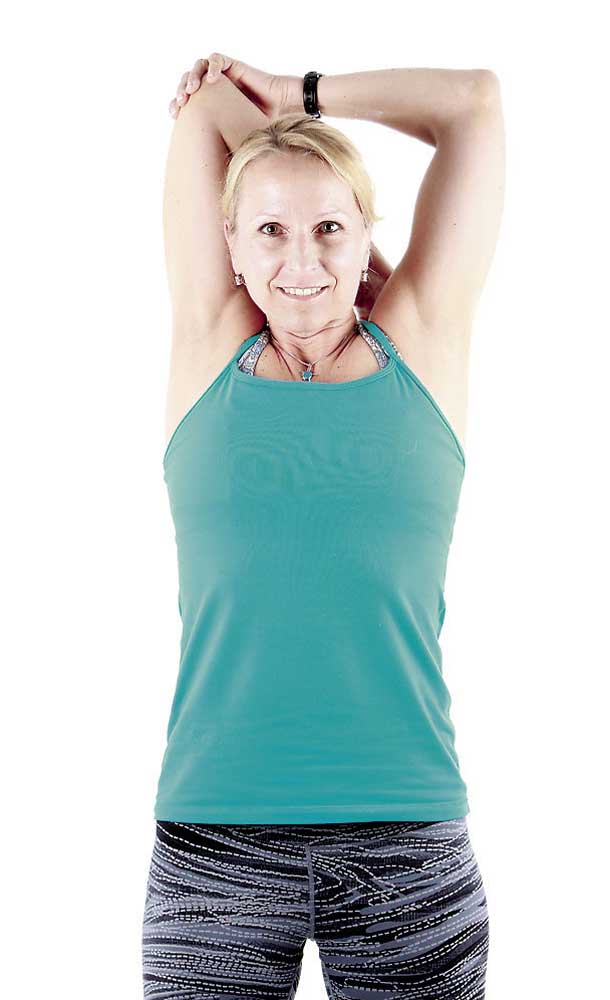Tips: How to stretch the right way
Published 12:00 am Monday, August 11, 2014

- Andy Tullis / The BulletinTricep stretch: Grab your elbow, bring it behind your body and gently pull. Repeat with opposite arm.
Hate to break it to you, but you may have been stretching wrong this whole time.
Were you doing it before your run? Were you pulling until it hurt? Both are major no-nos.
Sure, there are conflicting views in the fitness world over the best stretching techniques, and much of it depends on which research you trust.
For her part, Julie Downing, chair of Central Oregon Community College’s department of health and human performance and head of its Exercise Physiology Lab, relies on the American College of Sports Medicine’s fitness bible: the Guidelines for Exercise Testing and Prescription, which is updated every four years. Downing uses it to preach to her students about proper form and technique.
Whether you work out or not, stretching can increase the body’s range of motion so you can continue to do all of the activities of daily life, even as you age. And the more people can move their arms, legs and backs, the less likely they are to become injured because their muscles and tendons won’t budge, Downing said.
When to stretch
Although the common wisdom years ago was that stretching before a workout reduced the risk of getting injured, Downing said stretching before a workout actually dampens performance. Studies have tested runners who stretch before and after runs and found their times were slower when they stretched before runs, she said.
“It’s kind of wild,” she said.
Stretching elongates the muscles, thereby decreasing their ability to produce power.
“A nice, tight muscle can produce a lot of power, but a muscle that’s really stretched out cannot produce the same amount of power,” Downing said.
What people should actually do to prevent injuries, Downing said, is warm up before their activities. If you’re going for a ride on your mountain bike, a warm-up means going easy for five or 10 minutes. If you’re lifting weights, hop on an exercise bike for the same amount of time beforehand. If you’re running, start out with a slight jog or brisk walk.
Then when you’re done with the activity, spend the same amount of time in a cool-down mode, which can be the same type of activity as the warm-up.
Then, and only then, is it appropriate to stretch, Downing said.
“That’s when you’ll have the most elasticity because the muscle is more pliable,” she said.
How often
Downing recommends people stretch two to three times per week at a minimum, although daily is ideal. Of course, people should always stretch after they exercise, she said.
If people are just beginning a stretching routine, Downing said they should be patient — improvements in flexibility won’t show up until three to four weeks after beginning a stretching regimen. You’ll notice flexibility beginning to increase by doing a sit-and-reach test, for example, which is when you sit, stretching your legs out in front of you and try to touch your toes.
People should always stretch to the point where they feel slight tension or discomfort, but not pain.
Stretching style
There are several styles of stretching, but the ones Downing recommends for most people are static, which refers to holding a position for 10 to 30 seconds, or partner stretching, which means having another person apply resistance to improve your stretch.
All static stretches should be held for between 10 to 30 seconds, or for 30 to 60 seconds for people over the age of 60. Ideally, though, each stretch should be held for a grand total of 60 seconds. That means you could hold each one for, say, 15 seconds, take a one-second rest and then repeat that three additional times to get 60 seconds worth of stretch.
Partner stretching works equally as well, if not better, than static stretching, although it might take longer because partners have to stretch the other person as well as themselves, Downing said. These stretches work by having the partner apply resistance and, immediately following, the opposite person will experience a relaxation of the affected muscle group.•
{%PTips-p2 081114%}
{%PTips-p1 081114%}
{%PTips-p3 081114%}
{%PTips-p4 081114%}
{%PTips-p5 081114%}
{%PTips-p6x 081114%}
{%PTips-p8 081114%}
{%PTips-p9 081114%}
{%PTips-p12 081114%}






